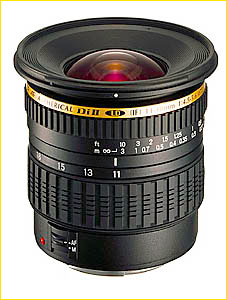
This is not a review. It is simply a quick evaluation of the new Tamron 11-18mm
based on a few days of casual shooting. No rigorous testing of the lens has been performed
and due to time constraints on the availability of this lens for evaluation, none is currently planned.
In early June, 2005 theTamron 11-18mmlens became available. This lens, in mounts for Nikon, Minolta and Canon, is Tamron’s first ultra-wide lens designed specifically for reduced frame (APS-C sized) sensors. In fact, while it will fit on a full frame film or DSLR, the image circle is insufficient to cover the full field. But, unlike Canon’s EFS lenses, such as its 10-22mm f/3.5-4.5, which are limited to S mount bodies such as the Rebel/XT and 20D, the Tamron will fit earlier reduced frame digital bodies such as the 10D, D60 and D30. If you put the lens on a film camera, or a full frame digital camera such as the Canon 1Ds MKII, you will not get a usable image outside of the APS-C sized format area. This lens is designed for current 1.5X and 1.6X digital cameras only.
The Tamron sells for about US $575 online. The competitiveCanon 10-22mm f.3.5-4.5 EFSsells for about $800, while theNikon 12-24mm f/4 DXretails for $940. So clearly the Tamron appeals on the basis of price alone. And when you add to this the fact that the Canon lense don’t include a lens hood, while the Tamron does, the price spread is even greater. To my knowledge Konica Minolta don’t have an ultra-wide zoom in their lens line-up at present (July, ’05), which should make a third party lens such as the Tamron even more appealing.
___________________________________________________________________
Getting Wide When You’re Reduced
One of the frustrations that owners of so called reduced-frame DSLRs have had for the past five or so years has been the lack of really wide angle lenses, especially zooms. Put a 20mm lens on a DSLR with an APS-C sized sensor and you’ve got a 30-32mm lens. No longer very wide. Even a 14mm lens, the widest prime available until recently, becomes a 21mm or 22mm lens; wide, but no longer super-wide.
During the past year or so manufacturers and third-party lens makers have started to deal with the problem by introducing ultra-wide zooms. These include the 12-24mm from Nikon, going out to the equivalent of 18mm at the wide end, and the 10-22mm from Canon, which gives a widest angle coverage equivalent of 16mm for Canon owners.

Canon 20D with Tamron SP 11-18 f/4.5-5.6 Di II LD @ 15mm. ISO 100
Cloudscape. Muskoka, July, 2005
Now Tamron has entered the fray, and its new 11-18mm offering appears to be an attractive offering, especially at several hundred dollars less than the camera maker’s products. And for Minolta owners, it’s one of the few choices available in the focal length range.
With that all said, and as noted at the top of the page, this is not a full review – rather, simply a casual look at what this new lens is all about. The reasons for it not being a full review are the limited time that I have the lens available for testing, and the fact that my DxO test bench is unavailable to me for the summer months.
While the main attraction of the Tamron 11-18mm is its price, this shouldn’t be the overwhelming factor. The lens appears to be quite well made. Without disassembling it it’s hard to comment on materials and long-term reliability, but it feels every bit as well made as the competition.
My point of comparison will be the Canon 10-22mm EFS, since that is what I use. I have no experience with the Nikon 12-24mm DX.
While the Canon is an f/3.5-4.5 lens, and the Nikon a fixed f/4, the Tamron is an f/4.5-5.6, this making it a half stop to a full stop slower than the others. This also makes it somewhat smaller and lighter.
The zoom ring on the Tamron has a smooth feel and the AF/MF switch clicks solidly into place. Mechanically, my main objection to the Tamron is that the focusing ring physically rotates as the camera autofocuses, whereas that on the Canon doesn’t. This can be disconcerting when the focusing ring under your fingers rotates as you’re trying to hold the lens. Also, because of this design, if you want to manually focus, or touch-up the autofocus, you have to set the lens to manual. With the Canon you can turn the stationary AF ring at any time, overriding the autofocus.
As a regular Canon user I was also a bit disconcerted by the fact that the focusing and zoom directions are opposite to the Canon norm. Nikon owners will of course not find this to be a problem.
___________________________________________________________________
Image Quality
One of the things to look at when choosing an ultra-wide angle lens is vignetting. While this can be corrected in the raw converter (if you’re using the latest Camera Raw, or in Photoshop with CS2), it is best if it’s minimal to begin with. One of the Tamron’s strengths appears to be the low vignetting that one sees, especially when compared to the Canon lens at wider settings. The photograph above titled Clouds, shows a high degree of freedom from vignetting, and other casual comparisons bore this out as well.


Though no technical tests were done, some casual shooting and print examinations show this to be a fine performer. The 100% crop above of my dog Cody’s fur gives some idea of this. I’ll leave it to the web sites and magazines that regularly specialize in such tests to give you the numbers, but even a critical user will not be dissatisfied with the Tamron’s day-to-day performance, especially when stopped down at least 1 stop from wide open – as is the case with most lenses.
___________________________________________________________________
Bottom Line
No, this isn’t one of my more rigorous lens tests, and lacks theDxOoptical bench results that I usually publish. But, before sending the lens back toAmplis Photo, the Canadian distributor for Tamron, who were kind enough to lend me the lens for a few days, I wanted to share myquick lookimpressions with you.
If you’re looking for an ultra-wide zoom for your 1.5x or 1.6x lens factor DSLR then I can recommend the Tamron SP 11-18 f/4.5-5.6 Di II LD to you. The price is attractive and the lens is capable of producing high quality images. If you are the owner of a Canon D30, D60 or 10D, and therefore unable to use the Canon 10-22mm lens without performing warranty destroying surgery, the new Tamron provides an attraction option.
You May Also Enjoy...
Kodak DCS Pro Back
This review is part of a larger series of ongoing articles and reviews of medium format digital backs.If you have not already done so you
